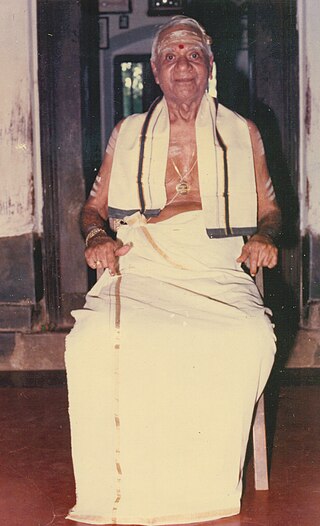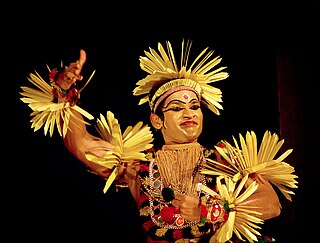
Koodiyattam is a traditional performing art form in the state of Kerala, India. It is a combination of ancient Sanskrit theatre with elements of Koothu, an ancient performing art from the Sangam era. It is officially recognised by UNESCO as a Masterpiece of the Oral and Intangible Heritage of Humanity.

Kunchan Nambiar was a prominent Malayalam poet of the 18th century (1705-1770). Apart from being a prolific poet, Nambiar is also famous as the originator of the dance art form of Thull'll, most of his works were written for use in Thullal performances. Social criticism wrapped in humour is the hallmark of his works. Nambiar is one of the foremost comedians in Malayalam.

Koothambalam or Kuttampalam (Kuṭṭampalam) meaning temple theatre or play house by scholars is a closed hall for staging Koothu ( , Nangiar koothu( and Koodiyattam , the ancient ritualistic art forms of Kerala, India. Koothambalams are said to be constructed according to the guide lines given in the chapter 2 of Nātyasāstra of Bharata Muni. The stage within the hall is considered to be as sacred as the temple sanctum. It is constructed within the cloister of the Temple; more precisely within the pancaprakaras of the temple. The prescribe location is between the prakaras of bahyahara and maryada. In Kerala tradition it is considered as one among the pancaprasadas of a temple complex. Its dimension vary from temple to temple. A square platform with a separate pyramidal roof supported by pillars in the center called natyamandapam is constructed as s separate structure within the large hall of Koothampalam. The floor of the hall is divided into two equal halves and one part is for performance and other half for seating audience. During the performance, the stage is decorated with fruit-bearing plantains, bunches of coconuts and fronds of the coconut palm. A para filled with rice is placed on the stage. A nilavilakku with three thiri is used for lighting. The mizhavu, a percussion instrument for accompanying Koothu, is placed within a railed enclosure, with a high seat for the drummer.

A mizhav or mizhavu is a big copper drum played as an accompanying percussion instrument in the Koodiyattam and Koothu, performing arts of Kerala. It is played by the Ambalavasi Nambiar community. After 1965, when started a mizhavu repertory in kalamandalam mizhavu break the caste barrier and nowadays anyone can play mizhavu in koodiyattam, nangiar koothu, chakyar koothu, and mizhavu thayambaka.

Guru Mani Madhava Chakyar (15 February 1899 – 14 January 1990) was a celebrated master performance artist and Sanskrit scholar from Kerala, India, considered to be the greatest Chakyar Koothu and Koodiyattam artist and authority of modern times. He was considered as the authority of Abhinaya and Nātyaśāstra.

Chakyar Koothu is a performance art from Kerala, India. It is primarily a type of highly refined monologue where the performer narrates episodes from Hindu epics and stories from the Puranas. Sometimes, however, it is also a traditional equivalent of the modern stand-up comedy act, incorporating commentary on current socio-political events.

The culture of Kerala has developed over the past millennia, with influences from other parts of India and abroad. It is defined by its antiquity and the organic continuity sustained by the Malayali people. Modern Kerala society took shape owing to migrations from different parts of India and abroad throughout Classical Antiquity.

The Indian state Kerala is well known for its diverse forms of performing arts. The various communities in Kerala contribute to its rich and colourful culture. The most important traditional art forms of Kerala are Kathakali, Kalaripayattu,Mayilpeeli Thookkam, Koodiyattam, Theyyam, Mohiniyattam, Thullal, Padayani, Pulikali, Thiruvathirakali, Chakyarkoothu,Chavittunadakam, etc.
Puthur Vela is an annual festival at the Puthur Thirupuraikkal Bhagavathy temple, located in Puthur, Kerala, India. The temple houses the Goddess Karnaki, who is believed to be an incarnation of Goddess Parvathi. This temple is famous locally and attracts several hundred devotees every year. The Kadhana vedi (firecrackers) are set off at 6 pm every day after the evening pooja.

Killikkurussimangalam is a village around 8 km from nearby town Ottappalam in Palakkad district of Kerala, south India. The river Nila (Bharatapuzha) flows through the southern border of Lakkidi.

Nātyakalpadrumam is a book written by Guru Māni Mādhava Chākyār, considered the greatest exponent of Koodiyattam and Abhinaya in Kerala, about all aspects of ancient Sanskrit drama theatre tradition of Kerala—Kutiyattam. It was first published in Malayalam (1975) by Kerala Kalamandalam, with financial assistance of Sangeet Natak Academi, New Delhi. This work serves as a reference to both scholars and students. The entire book is written in the old Sanskrit text style closely following Nātyaśāstra. The structure and content of the book alike illustrate the knowledge of the author in both Sanskrit and Nātyaśāstra. The work received the Kerala Sahitya Academy Award in the year 1975. A Hindi translation has been published by the Sangeet Natak Akademi, New Delhi.

Nangiar koothu or Nangyar Koothu is an allied traditional art of Kutiyattam, an age-old Sanskrit drama tradition of India. It is performed traditionally by the women of the Ambalavasi Nambiar community of Kerala, known as Nangyaramma, but since the second half of the 20th century it's no longer the case.
Theeyaattam also known as Theeyaattu (Tīyāttu) is a traditional temple dance form of Kerala.
Kalamandalam Prabhakaran is an Indian dancer.
Paanivadathilakan P. K. Narayanan Nambiar was an Indian musician, known for his virtuosity in Mizhavu, a traditional percussion instrument and his scholarship in the art of Koodiyattom. He is considered to be one of the masters of Koodiyattom. In 2008, he was awarded Padmashri by Government of India for his services to the art.
Kalamandalam Sivan Namboodiri is an Indian classical theatre performer, the first person from outside chakyar community to practice Koodiyattam, from Kerala. He was awarded the Padma Shri, in 2012, for his contributions to the art of Koodiyattam, by the Government of India.

Pathakam is a traditional temple art form of Kerala in which stories from Hindu Puranas are narrated.
Parayan Thullal is a dance and poetic performance form prevailed in the state of Kerala, India. This one of the three major thullal forms prevailing in Kerala. Others are Ottan Thullal and Sheethankan Thullal. Usually, it is conducted in the morning time. The Sanskrit metre Mallika is commonly used in this art form.

Sheethankan Thullal is a dance and poetic performance form in Kerala, India. This one of the three major thullal forms prevailing in Kerala. Others are Ottan Thullal and Parayan Thullal. This dance is performed in a very slow tempo. It gives importance to gestures than vocal actions.
Kerala Sangeetha Nataka Akademi Award is an award given by the Kerala Sangeetha Nataka Akademi, an autonomous organisation for the encouragement, preservation, and documentation of the performing arts of Kerala, set up by the Department of Cultural Affairs of the Government of Kerala. Instituted in 1962, the awards are given in the categories of music, dance, theatre, other traditional arts, and for contribution/scholarship in performing arts. The award consists of Rs. 30,000, a citation and a plaque. The recipients of the award are also conferred the title Kalasree.


















